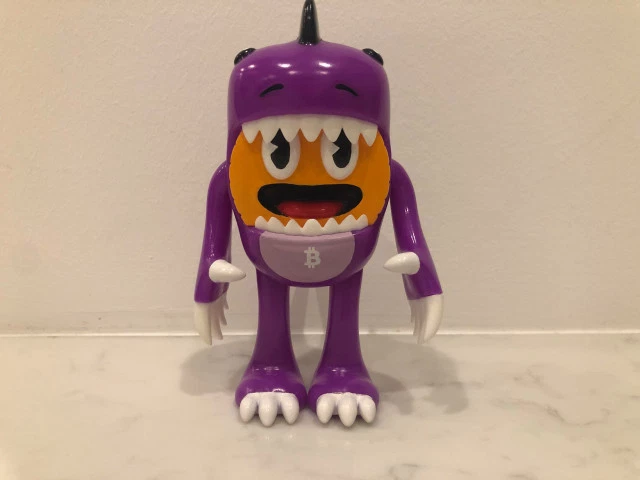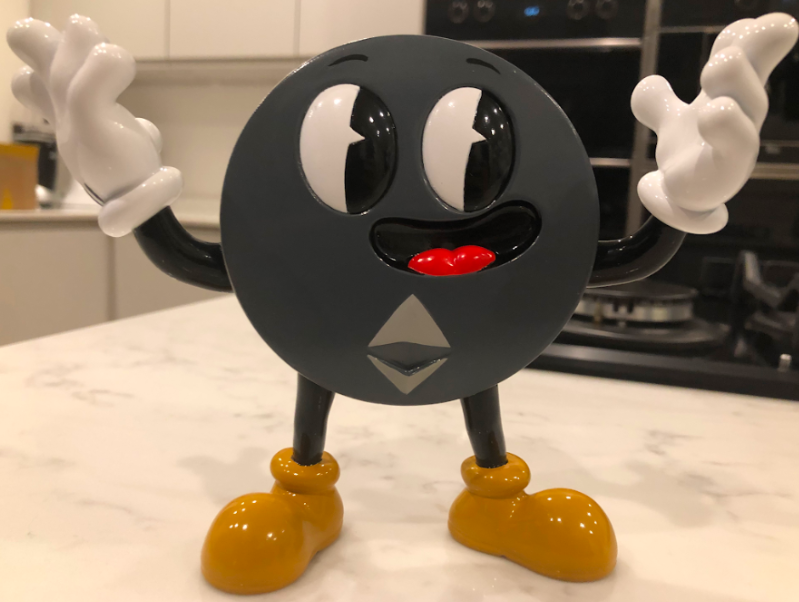Cryptocollectibles, like the (in)famous CryptoKitties, generally exist in digital form only. Tying physical artwork to unique, digital tokens is notoriously difficult, but a new type of cryptocollectible that launched today is attempting to bridge this gap.
CryptoKaiju are vinyl toys that look like cryptocurrency-themed monsters (hence the name—“kaiju,” which translates from Japanese as “strange beast”). Creator Oliver Carding has collected designer vinyl toys, like Kaws, since his late teens, and he founded CoinJournal, a blockchain news site, four years ago. His combined interests brought up a new use case for nonfungible ERC-721 tokens, the type that ensure the uniqueness of each CryptoKitty. They could verify the “provenance, authenticity, and scarcity” of vinyl toys, he told BREAKER from his home in Manchester, U.K.
Each CryptoKaiju has a near field communication (NFC) chip (a type of radio-frequency identification, or RFID, chip) embedded in its foot that’s connected to an ERC-721 token. The concept is similar to other use cases, like using blockchain to fight counterfeit fashion, for instance. But in this case, each token is connected to a smart contract, accessible via smartphone, that also includes information about the toy that makes it “truly” one-of-a-kind. “Truly” because physically, one toy might exactly resemble another, but their metadata are different.
The first 130 “Genesis” toys to be released will all look like either green or purple versions of this toy, aka, little bitcoin-themed creatures wearing dinosaur costumes:
A "rare" purple CryptoKaiju, part of the "Genesis" set of 130.

There will be fewer purple versions than green ones (because collectors love scarcity), but otherwise they’ll all appear identical. That is, until you get a look at their smart contracts, which may denote one as male and another as female, or indicate that one is “creative” while another is “adventurous.” “So you can get a green dinosaur that’s an adventurer,” said Carding, “so say out of that 130 there could be two green adventurers.”
One CryptoKaiju will go for $55, while a yearlong figure-of-the-month subscription costs $600. For comparison, a Kaws vinyl figure can cost a few hundred. A six-month subscription option for $320 was added due to the recent decline in crypto prices, though 2,000 people have already signed up to get information about CryptoKaiju’s launch, Carding said. The company accepts payment through either Coinbase or Stripe, for those who prefer to buy their vinyl crypto monsters in fiat.
 Did the world need a blockchain-based vinyl collectible? Though the knee-jerk answer for most would be “no,” these creatures will mark one of the first useable versions of an RFID-blockchain connection, a development that’s been widely discussed as a way to solve problems in supply-chain tracking. Alone, RFID chips can be tampered with, and it’s hard to reliably connect a digital ledger, however immutable it is, to physical products. Together, the two technologies might have a better chance at tracking products’ physical journeys.
Did the world need a blockchain-based vinyl collectible? Though the knee-jerk answer for most would be “no,” these creatures will mark one of the first useable versions of an RFID-blockchain connection, a development that’s been widely discussed as a way to solve problems in supply-chain tracking. Alone, RFID chips can be tampered with, and it’s hard to reliably connect a digital ledger, however immutable it is, to physical products. Together, the two technologies might have a better chance at tracking products’ physical journeys.
Then there are the collectors, who don’t need anything but want all kinds of things. “Honestly, I didn’t know what the market [for CryptoKaiju] was going to look like,” said Carding. “It’s a passion project; I’ve always wanted to make a toy, so we put out social media posts and found that the Ethereum people and some of the vinyl enthusiasts, there is a crossover in those markets.”
Other CryptoKaiju set to debut will have ties to cryptocurrencies. The next one looks like an Ethereum M&M, and the one after that will be a “gorilla banker,” which looks like how it sounds.
Trading them, however, hasn’t quite been figured out yet—a pretty significant issue for a collectible tracked on a blockchain. “We’re advising trading with somebody you actually know and can trust,” said Carding. “We’re really keen on using trusted escrow smart contracts and trying to build a trading platform, and that’s difficult.” (So much for a trustless system.) Carding and his team, the cofounders of digital art marketplace KnownOrigin, Andy Gray, David Moore, and James Morgan, plan to work on that “once we get some users on the platform.” This means the CryptoKaiju team hasn’t solved the final step in connecting the digital and physical. Sure, the toy is connected to its token, but owners aren’t obligated to track their trades, so the physical toys could change hands as easily as a Pokemon card without an update to the blockchain.
People collect all kinds of things, from pressed pennies to Beanie Babies, stamps, baseball cards, and hollow-eyed Hummel dolls, and collections typically come with a marketplace and a corresponding verification business (see, for example, the American Philatelic Society’s stamp authentication service, where members receive “discounted rates”). Until you can track trading, toys shaped like bitcoins dressed as dinosaurs have a ways to go before becoming the next big thing in the already-bizarre collector’s universe.